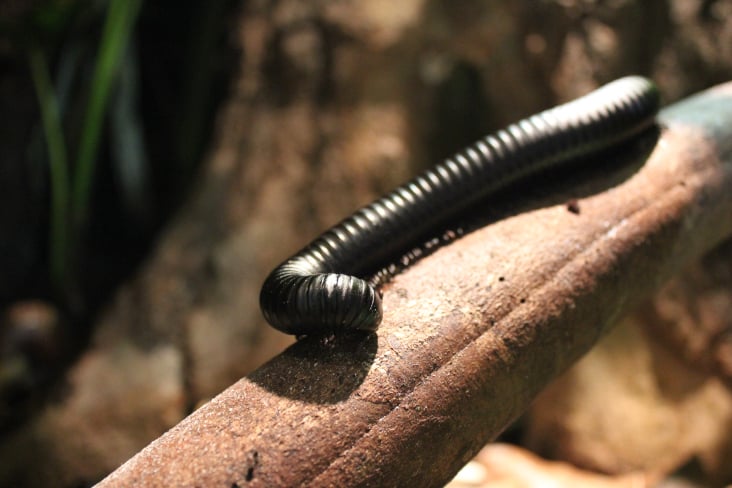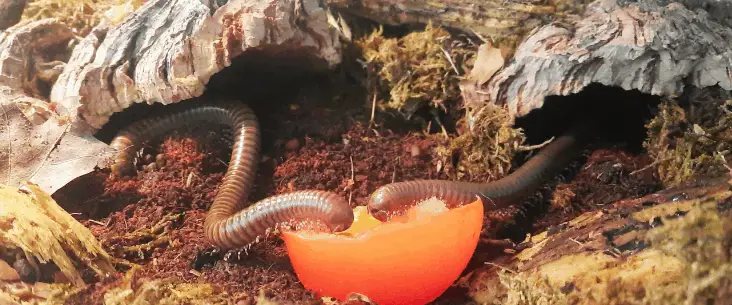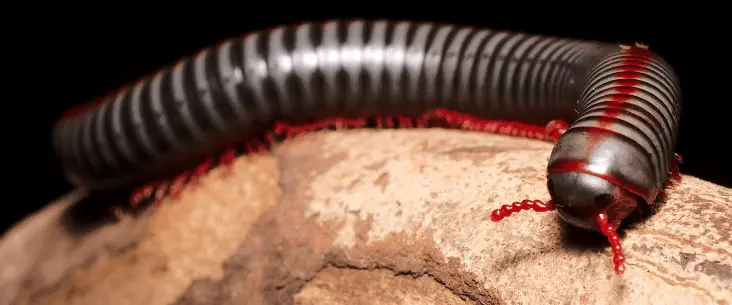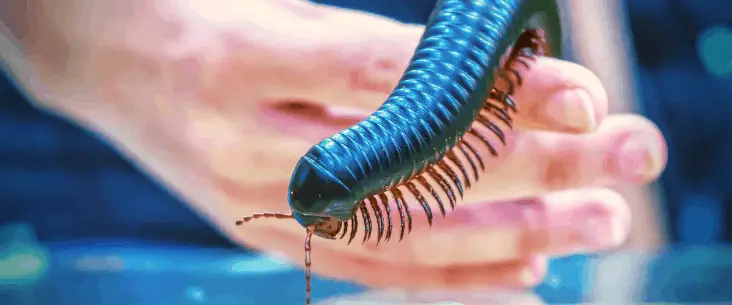Millipedes are popular pets. They propel their long tubed body with their many legs, always in search to munch on decaying organic material. These animals are perfect pets for kids. If you are careful, you can let them walk on your hand. But for most of the time, they will be in their own optimized habitat. But, how do you make a millipede habitat that is perfect for your little friend? Keeping them is quite easy, but there are some things you just need to have right for your millipede to be healthy and happy. This article provides a checklist of how you can make the perfect habitat for your millipede in 6 easy steps!
A millipede needs a reasonably sized enclosure that is at least 3 times its body length in width and 2 times the body length in height. A good quality substrate is the most important part of the millipede habitat, and they need an environment that is lightly humid with a temperature ranging between 72°F and 78°F (22°C – 26°C).
Want to know how to set up a millipede enclosure? With the use of 6 easy steps, you can create the perfect habitat for your millipede so that you can enjoy your leggy pet for many years. Let’s get to it then.
How to set up a millipede habitat? The 6 easy step checklist!
With this checklist, we discuss all aspects you need to know to set up a proper habitat for your millipede. They don’t need much, but if you do not provide the basics they need, they will become unhappy and don’t have a long life. The advice provided here is suitable for most millipede species; however, it is always important to research your millipede species and make little adjustments if necessary. So, that is step 1!
1. Research the needs of your millipede
Every animal has its own needs. The need for certain care, the need for a certain food, the need for a certain environment, and the need for a certain space. So it is important to research the needs of your species on forehand before making decisions about the millipede habitat.
Questions that need to be answered is where they live in the wild. What is the climate there (temperature and humidity? Do they like to climb? How large will they become? What is their average lifespan? This way, you get a basic understanding of your new pet. For many millipede species, there are care guides or care sheets where people describe the species’ needs. Know that not every millipede has the same needs.
On this website, we have described some millipede species ourselves. If you are completely new to keeping millipedes, I advise you to read our guide on the basics of keeping and caring for millipedes. It provides you with the fundamental knowledge about what it takes to keep millipedes as a pet.

2. Find a proper millipede tank (type and size)
There are not many tanks specially made for millipedes, but most reptile terrariums are perfectly fine to house a millipede. You can also choose an aquarium, acryl tank or plastic container to keep your millipede. Keep in mind that these latter types of enclosures often need some adjustments to make them suitable. There are two important aspects that the enclosure need: A proper size and good ventilation. Although there is more to think about, let’s discuss these first two.
The enclosure size
The general rule for every millipede is to find an enclosure that is at least three times the adult body length in width and two times to body length in height. This the minimum for when you keep one millipede. If you like to keep more millipedes in the same enclosure, you should look for a larger tank. Remember when you want to keep more than one millipede, that the floor space is more important for millipedes than the height of the enclosure.
This means that if you plan to keep a millipede that has an adult body length of 6″ (15cm), you should have an enclosure that is at least 18″ (45cm) wide and 12″ (30cm) high. I like to keep them in larger enclosures than the minimum. Although some species don’t walk that much, I like to provide space for them to keep them happy. A larger enclosure also means that there is room for the substrate. But more on that later.
Good ventilation
Besides the size of the enclosure, good ventilation is also important to have. Without proper ventilation, stagnant air will accumulate moisture and make the substrate too wet, which in turn cause bacteria and mould to grow exponentially. Your enclosure needs proper ventilation for your millipedes to stay healthy.
Terrariums are often equipped with enough ventilation. Many terrarium models have a mesh lid and ventilation on the front or the backside. If you use some other type of tank, like a plastic container or an old aquarium, you must create this ventilation yourself. You can drill multiple small holes or make large holes and cover them with wire mesh.
Other useful features
Some other features can be helpful. The first thing is that the enclosure has no holes or gaps where millipedes can escape. Especially with smaller millipedes — especially when you breed with them — they can easily push themselves through little gaps if, for example, the lid does not close off that well.
It would be best if you have a solid bottom plate to place enough substrate in the enclosure. The enclosure must at least be able to hold a substrate layer of 2″ (5cm).
Preferably the enclosure has good access to the enclosure with a large lid on top or doors at the front, so you can easily feed the animal(s) and clean plus misting the enclosure.
3. Substrate is a life changer (you can’t do without!)
I can’t say it enough, but the substrate is one of the most important elements of the habitat setup. For millipedes, the substrate means life. It sounds very serious, and it also is. Millipedes are detritivorous, which means they feed primarily on decaying organic matter. Besides that, they live primarily in or on the substrate where they rest, sleep, reproduce, lay eggs, and moult.
Therefore millipedes need a proper layer of a good quality substrate in the enclosure. A layer of around 2.5″ (6cm) will do. In my opinion, coconut fibre mixed with partly decaying leaves and rotten wood is the best substrate you can provide to your millipede.
As already mentioned, the substrate has many perks for the animals. For a full guide on what substrate is best, how to make the substrate, and how to maintain it in good condition, I recommend you to read: Substrate For Millipedes: What You Should Know.
4. Furnishing and decorate the enclosure
When you have a proper-sized enclosure filled with a good layer of substrate, you are halfway there. Now it is time to furnish the enclosure and decorate as you like. Apart from some hiding places — although the substrate can be already enough — there is not much they necessarily need.
However, you can decorate the enclosure with wood, twigs, live plants, artificial plants and some pebbles. Don’t use weighty objects. When they are hiding under there, it can squeeze and damage the animal. Some millipedes actually like to climb once in a while, so offering some climbing opportunities is a good practice. Especially bumblebee millipedes and African black giant millipedes can regularly be seen climbing on twigs and other objects.

5. Create and maintain the correct environment
At this point, the habitat is actually finished and ready for your new millipede to move in. There is only one last step that is also pretty important for your millipede to keep them happy: provide a nice climate. That means you need to regulate three things: humidity, temperature and lighting.
We touched on this topic earlier that a millipede needs a slightly moist environment. They like a humid habitat and moist substrate. With that, I really mean moist, not (soaking) wet. You can keep the environment moist by mist spraying water into the enclosure. Try to keep the substrate damp, and every time it has dried up, you spray again. Normally this will mean you have to spray every or every other day.
You can regulate the temperature in two ways. You can use a light bulb as a heating source or a heating pad. I prefer using a light bulb as a heating source for two reasons: first, it also lights up the enclosure and makes a normal day and night cycle and second, it does less dry out the substrate. When you use a heating pad below the enclosure, it heats up the substrate, and the moisture in it will evaporate much quicker. If you want to use a heating pad, you could also mount it to the backside of the enclosure.
Millipedes can be kept in a normal day/night cycle. Use a normal light bulb for this, and not (direct) sunlight. If you place the enclosure into direct sunlight will quickly heat up the enclosure up to temperatures lethal to millipedes. You can compare it with leaving a dog in a car that’s parked in the sun with all windows closed. Try to find a location that has a pretty steady temperature.
6. Introduce your millipede to its enclosure
Your millipede’s new home is ready. Now it is time to place the millipede carefully in the enclosure. Because it is all new to him or her, it will quickly burrow itself in the substrate. This is perfectly fine, and it will probably not show itself for several days. Give your animal some time to get used to its new environment. Never dig up your millipede when it is not absolutely necessary. This can be very stressful for the animal.
Now you can enjoy your new pet’s home, observe its beautiful behaviour. When you have multiple millipedes, you may find little baby millipedes after a while. Many millipedes are quite easy to breed in captivity.
You can read more about the care of millipedes in our millipede care guide.
7. BONUS: Communal setups
Keeping millipedes with other animals is possible. This is called a communal setup. Not all animals are suitable to be kept together. The basic rule is that the animals will not fight each other or compete on food or space. If you are interested in keeping different species together, it is best to find animals that live in other layers of the enclosure or have completely other diets.
Suitable species that you can keep with millipedes that I know are successful are flower beetles, snails, and stick insects. However, you can also keep tree frogs or geckos together with millipedes if you like.
If you like to know more I recommend you to read our article about communal setups with millipedes.
Much more to learn!
There is much more to learn about stick insects. For example, can you keep different millipede species together? You can find more articles about millipedes with plenty of practical tips to better understand and enjoy the keeping of millipedes as a pet.
Share this page!




